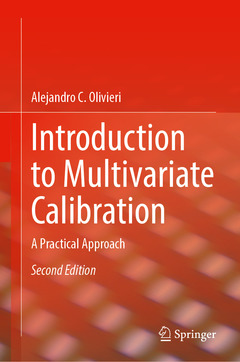Introduction to Multivariate Calibration (2nd Ed., 2nd ed. 2024) A Practical Approach
Auteur : Olivieri Alejandro C.

This book contains several new sections that provide even more in-depth knowledge on the topics. New content on the classical least-squares model, which shows its advantages and limitations in greater detail, was added. Additionally, the book contains a new section on the inverse least-squares model, which explains how it differs from the classical model and its applications in chemometrics. Furthermore, a new chapter on principal component analysis, which covers the concept in greater detail and its applications in chemometrics, is added. This book also includes several real-world examples to help you better understand the topic. Overall, this book provides the reader with even more comprehensive knowledge on chemometrics and multivariate calibration, making it an essential resource for students and professionals alike.
1. Chemometrics and Multivariate Calibration.- 2. The Classical Least-Squares Model.- 3. The Inverse Least-Squares Model.- 4. Principal Component Analysis.- 5. Principal Component Regression.
Prof. Dr. Alejandro César Olivieri obtained his B.Sc. in Industrial Chemistry from the Catholic Faculty of Chemistry and Engineering, Argentina, in 1982, and his Ph.D. from the Faculty of Biochemical and Pharmaceutical Sciences, University of Rosario, Argentina, in 1986. He works in the Department of Analytical Chemistry of the latter Faculty and is a fellow of the National Research Council of Argentina (CONICET). His primary research field is multivariate calibration, including first- and higher-order models, analytical figures of merit, and software development.
Date de parution : 09-2024
Ouvrage de 455 p.
15.5x23.5 cm
À paraître
Thèmes d’Introduction to Multivariate Calibration :
Mots-clés :
Multivariate calibration; Partial least-squares regression; Analytical figures of merit; Software for multivariate models; Spectral pre-processing; Direct and inverse calibration models; MVC1 software; Chemometrics introduction; Multivariate calibration textbook; Guide to multivariate calibration; First-Order Multivariate Calibration
